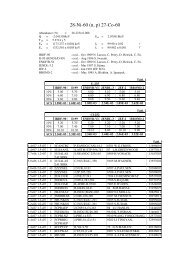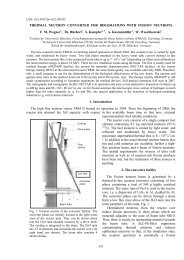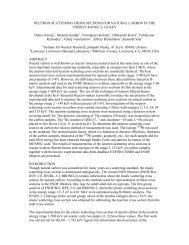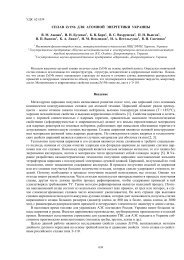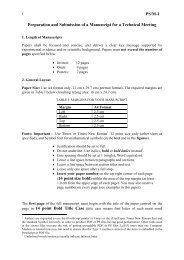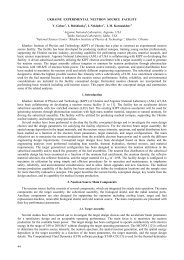International Reactor Dosimetry File 2002 - IAEA Publications
International Reactor Dosimetry File 2002 - IAEA Publications
International Reactor Dosimetry File 2002 - IAEA Publications
Create successful ePaper yourself
Turn your PDF publications into a flip-book with our unique Google optimized e-Paper software.
10 2<br />
Damage (MeV· mb)<br />
10 1<br />
10 0<br />
10 –1<br />
10 –2<br />
10 –3 10 –10 10 –9 10 –8 10 –7 10 –6 10 –5 10 –4 10 –3 10 –2 10 –1 10 0 10 1 10 2<br />
Neutron energy (MeV)<br />
FIG. 8.2. Energy dependence of silicon displacement damage response function.<br />
correlation depends on the assumption that displacement effects are the<br />
dominant radiation damage mechanism and that equal numbers of initially<br />
displaced atoms produce equal changes in device performance. Experimental<br />
evidence indicates that displacement kerma is not a valid measure of changes in<br />
the fundamental properties (carrier concentration, mobility and carrier<br />
lifetime) that determine device performance [8.9, 8.10]. The reason that the<br />
displacement kerma does not correlate with the property changes in GaAs over<br />
the entire range of neutron energies of interest is attributed to variations in the<br />
defect production efficiency for different sizes of displacement cascades. This<br />
effect is also known to occur in other types of material, including structural<br />
metals [8.11]. Despite these deficiencies (a lack of a strict proportionality<br />
between the observed GaAs semiconductor damage and the calculated<br />
displacement kerma), displacement kerma is still useful as an exposure<br />
parameter, and is analogous to the use of dpa for exposures of iron.<br />
Empirical efficiency factors that depend on the energies of the primary<br />
knock-on atoms (PKA) have been proposed in order to remove the discrepancies<br />
described above [8.9]. Figure 8.3 shows the shape of the empirical<br />
damage efficiency factor for GaAs, and can be described by an empirical<br />
function. As in Ref. [8.11], this PKA energy damage efficiency factor is used in<br />
conjunction with a normalization factor of 2.2 to preserve the equivalence of<br />
the GaAs damage function and the displacement kerma for 1 MeV neutrons.<br />
The results of the calculation of GaAs displacement kerma factors<br />
(displacement kerma per unit neutron fluence) are shown in Fig. 8.4 as a<br />
function of neutron energy. Figure 8.5 shows the complete energy dependence<br />
of the GaAs damage function. The unit of the kerma factor is megaelectronvolts<br />
times millibarns (MeV·mb). The kerma factor can be multiplied by<br />
95



